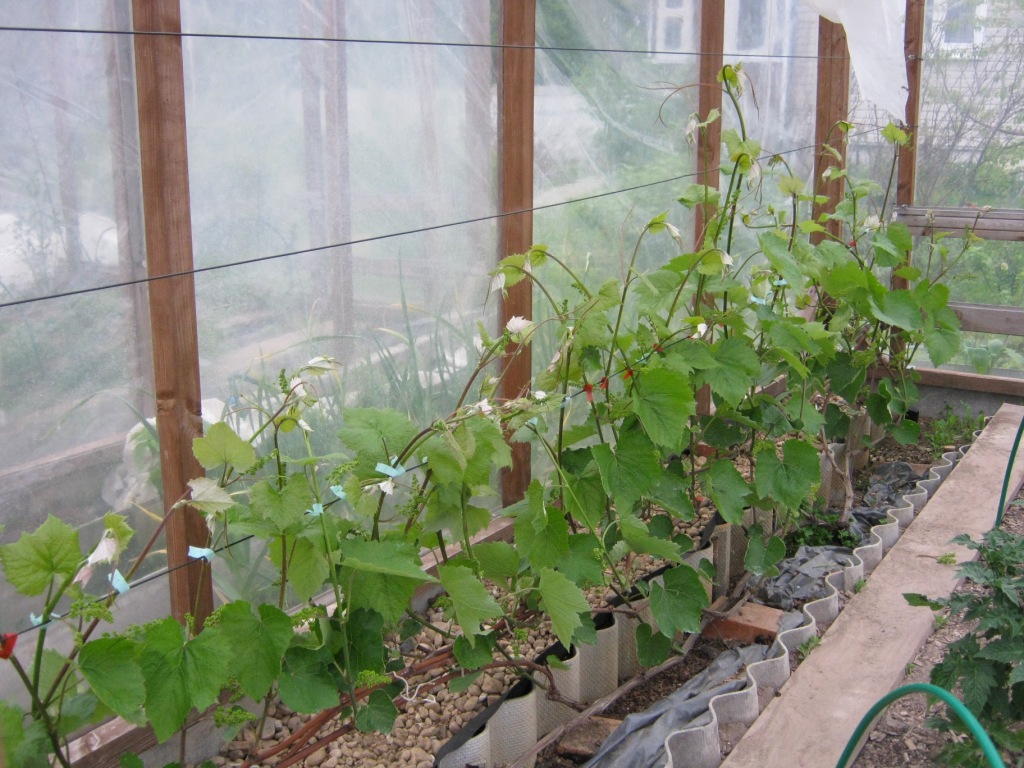
Grapes are a thermophilic culture, more suitable for the southern regions of the country. However, the enterprising summer residents of central Russia and Siberia, where the climate is characterized by short summers and frequent spring frosts, came up with the idea of cultivating grapes in sheltered soil, thus obtaining quite good yields.
Content
- 1 The benefits of growing in a greenhouse
- 2 Grade selection
- 3 Greenhouse requirements
- 4 Preparatory work
- 5 DIY trellis
- 6 Buying seedlings
- 7 Planting grape seedlings
- 8 Care
- 9 Fruiting problems
- 10 Rules for growing greenhouse grapes in the suburbs
- 11 Rules for growing greenhouse grapes in Siberia
- 12 Rules for growing greenhouse grapes in the Urals
- 13 Reviews
- 14 Conclusion
The benefits of growing in a greenhouse
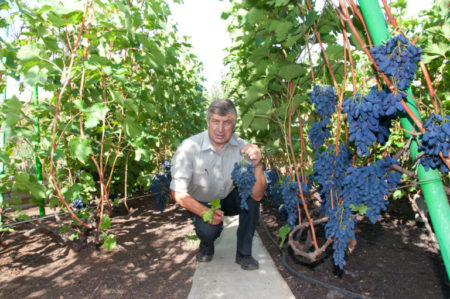
Cultivation of the crop in sheltered soil has solid advantages. Growing in a greenhouse, you can not worry about the fact that the grapes do not have time to ripen before the onset of cold weather, because the climate in the greenhouse can be controlled independently. In addition, even in the south, many winegrowers prefer to grow berries in closed ground, because this way you can get the crop much earlier. This is especially true for those farmers who are engaged in entrepreneurial activities and grow grapes for sale. The advantages of greenhouse cultivation include also:
- Lack of problems with harmful insects and diseases - all living creatures, including wasps, which often spoil berries, rarely get into the greenhouse. Diseases such as mildew and oidium appear extremely rarely in greenhouses.
- Plants are protected from adverse weather conditions, whether it is rain, wind or sunshine. Grapes grow and develop in static climatic conditions.
- The growing technology is simple. Plant care is convenient. There is no need to additionally treat the bushes with fungicides and insecticides.
- Berries do not crack from precipitation, and brushes do not fall apart from windy gusts. This allows the gardener to collect a full crop in full.
- The taste of the fruit remains at the level, not inferior to ground grapes.
Grade selection
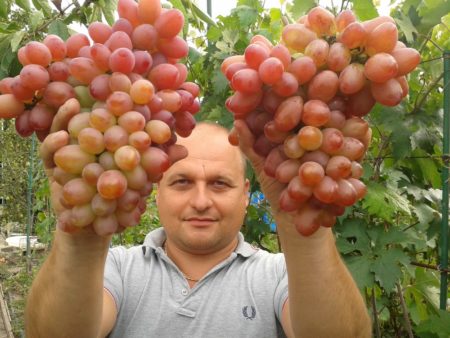
Almost all varieties are suitable for greenhouse cultivation, however, those that have early ripening periods show the best productivity. It is preferable for the first time to pick up cold-resistant, highly immune, shade-tolerant varieties that are guaranteed to give a good offspring. Given the size and height of the greenhouse, it is recommended to give priority to medium-sized and slightly branched varieties.
Table of the most suitable varieties for the greenhouse:
| Grade name | Vegetation period | a brief description of |
| Laura | 110-115 days | High yield. Large berries. Great taste. The mass of the bunch is up to 2.5 kilograms. |
| Song (White Wonder) | 110-115 days | The berries are large, with a high sugar content. The color of the fruit is light green. |
| Hothouse black | 115-125 days | Self-pollinating grade. The taste of berries is mediocre. Low resistance to fungal diseases. |
| Memory of Dombkowska | 155 days | High yielding. It has high immunity. Frost resistant. |
| Arcadia | 115-125 days | Productivity is above average. Cold-resistant up to -21 degrees. Not subject to mildew. Compatible with many rootstocks. |
| Moscow steady | 130-140 days | Frost-resistant grade (up to -25 degrees). It has enviable health. The taste of berries is good. |
| Korinka Russian | 110-120 days | Vigorous bush.Resistant to mildew, often affected by oidium. It tolerates frosts up to -28 degrees. |
Greenhouse requirements
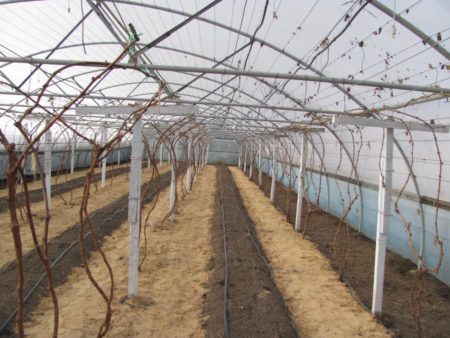
In a properly equipped greenhouse, all phases of the vegetation of a grape plant go much faster than in open ground, on average, for two weeks. Grapes can be grown in unheated and heated greenhouses. In the first case, the crop can be obtained 3 weeks earlier than usual, in the second - for a month.
What should be a greenhouse:
- The height of the greenhouse design should be at least 2.5 meters. For private farms, a small room is suitable, while grapes grown for sale need a lot of space.
- The frame should stand on a solid and deep foundation, which will reliably protect the greenhouse soil from the ingress of soil pests and weeds. You can build a shallow strip concrete foundation.
- Optimal for growing grapes is a polycarbonate greenhouse. This material is good in transmitting light and has good thermal insulation. For non-heated rooms suitable film or glass.
- In the upper part there should be a vent for full ventilation of the room;
- If a heat-loving variety is cultivated, then the greenhouse must be heated using a fan heater, heating radiator. For additional lighting, phytolamps are used.
- For the winter, walls (film, glass) should be removed so that the earth is “breathed” with oxygen and saturated with moisture from the snow.
Preparatory work
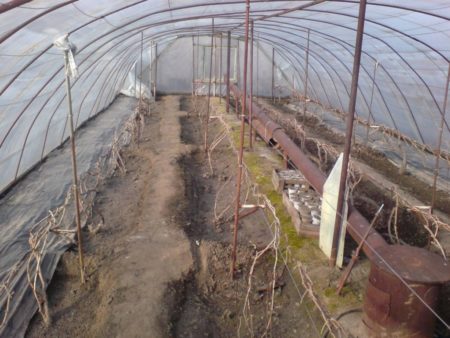
When growing grapes in protected ground, you need to know one nuance: a grape seedling can be planted outside the greenhouse, but the trunk itself and the vines should be inside it. Therefore, in the lower part of the greenhouse wall, you need to make a hole and stick the stem into the greenhouse zone, and part of the plant that is left outside can be covered with earth or grass mulch.
The soil should be thoroughly warmed up, the approximate temperature is 10 degrees heat. To do this, the greenhouse is heated artificially. The soil should be loose, soft, slightly acidic. The necessary substrate is made up of different parts of peat (3 parts), loamy earth (7 parts), sand (3 parts), crushed chalk or lime (50 grams per bucket of land), mineral fertilizers (50 grams of nitrogen, 30 grams of superphosphate, 15 grams potassium). Ready soil mixture is poured into deep pits, in which young seedlings will subsequently be planted (if planting is carried out in a greenhouse).
In the room you need to install trellises in advance, pull the wire on which the garter will be made. The wire must be placed at a distance of 20 centimeters from the glass in order to bypass the burns of the vine. The distance between the wire rows should be about 20 centimeters.
DIY trellis
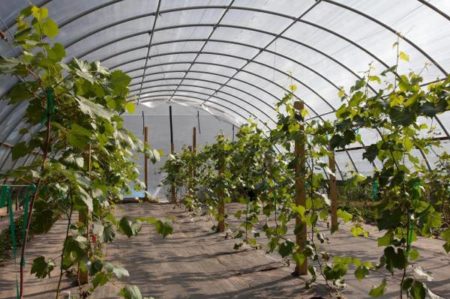
The grape bush, which is characterized by strong stature and branching, needs a garter to support. Usually, trellis is used as supports - several pillars driven along the bed, between which string layers are stretched to garter the vines. In the greenhouse, it is permissible to use T-shaped, single-plane and horizontal trellises, which can be done with your own hands.
Vertical Single Plane Trellis
The essence of such a trellis is such that along the growth of the vine bushes at equal distance from each other high metal pipes or wooden stakes are driven into the ground, between which a wire or a strong thread is stretched. The lash is tied to the wire in a horizontal position. The next lash, which is located above the previous one, will be tied in the same way to the upper layer of the wire, etc.
The distance between the filament wires - 35-40 centimeters - is the optimal value so that each lash can be well ventilated and illuminated by the sun. Between the stakes (or pipes) leave a gap of one meter. If they are installed a little wider, then the filament layer will sag, and the branches will fall or break.
Horizontal trellis
The design of such support devices is somewhat different from vertical ones. T-shaped or simply vertical posts are installed along the row, on top of which the wire is pulled along and across the greenhouse. The result is something like a grid or lattice with mesh sizes of 30 * 40 centimeters. The lashes are allowed to grow along this lattice (the same method is used in vertical gardening). And although the construction turns out to be cumbersome, it nevertheless facilitates harvesting, since the clusters hang from the ceiling during ripening and it is quite simple to remove them from the bush.
Buying seedlings
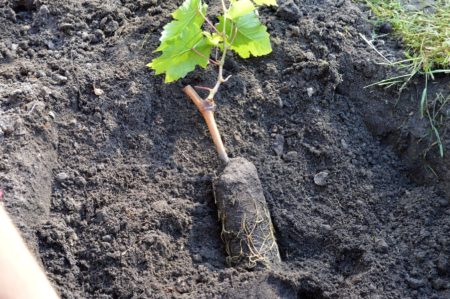
Both green root and grafted seedlings are suitable for greenhouse cultivation. But no matter what pedigree the plant has, it must have a healthy and most importantly strong root system. The more roots, the faster and better the seedling will take root. If you cut off a part of the root, then the cut should be white and wet. Dry, stained, deformed roots will indicate that the plant is at the stage of death.
The trunk should be smooth, clean, brown. If you slightly push the fibers of the wood, then under it you can see a moist greenish area, talking about the youth and health of the seedling. There should be no husks on the kidneys.
What seedlings are undesirable to buy:
- if the root system is open, that is, it is not in a wet substrate. In the air, the roots dry out quickly, deteriorate, perish;
- if there is foliage on the autumn seedlings. Oblivost takes away the forces of a plant, which in this way does not reach spring.
- if at least one bush with signs of illness is seen among the seedlings for sale. Most likely, most of the neighboring seedlings managed to become infected.
Planting grape seedlings
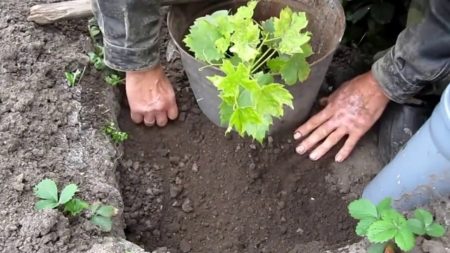
It is possible to plant annual seedlings or rooted cuttings in early spring, when the greenhouse air and soil warm up enough. From the wall of the greenhouse to the place of planting of seedlings, it is necessary to leave a place of 30-40 centimeters.
Grape planting in stages:
- For seedlings, they dig individual deep holes measuring 50 * 50 centimeters. Depth - 70 centimeters. The distance between the pits is 50-70 centimeters.
- The bottom of the pit is drained with broken brick, crushed stone, expanded clay. The drainage layer is 20-25 centimeters.
- Garden soil mixed with humus, minerals, sand (or peat), ash is poured on top. The layer is compacted.
- At the edge of the pit they stick a thick watering pipe. Its height above the ground should remain at the level of 10 centimeters.
- At the bottom in the center a small mound is poured, on which a seedling is installed in an upright position. The roots are spread along the mound so that they look exclusively down.
- Fill the soil.
- From above the earth is compacted and watered.
Care
Care for young, and then fruit-bearing grapes is reduced to systematic watering, the formation of shoots, and control of the microclimate. The environment should be comfortable for the culture - the growth of the vine bush will depend on the temperature, the amount of sunlight and loose soil.
Features of watering
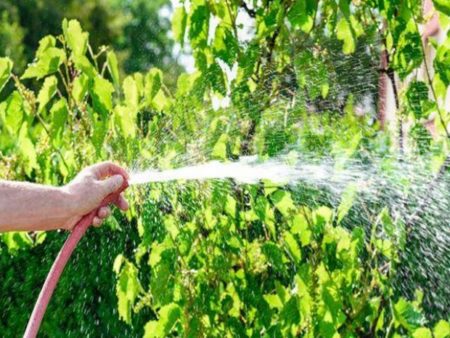
Greenhouse grapes are watered less often than ground grapes, since moisture in the greenhouse stays in the soil longer. For the first time, the bush is watered immediately after planting.Then, as soon as it takes root, watering is carried out once every 7-10 days, as the top layer of soil dries up. During flowering and ripening of fruits, the plant needs less. From early July to mid-August, the plant is watered once every two weeks.
Temperature
For grapes growing in sheltered soil, it is important to observe the condition of a suitable temperature. At the time of planting, the greenhouse should have an average of +10 degrees. Then, the temperature is gradually increased, reaching the moment of budding of the kidneys up to +24 degrees. At night, the plant is enough + 16-18 degrees. When the fruit ovaries appear and the crop begins to ripen later, the temperature can rise to +30 degrees - this is the best indicator for a grape plant.
Controlling the microclimate of the room, it is important to prevent stuffiness, accumulation of water condensate on the leaves and stems, and the appearance of an earth crust. During hot days it is better to shade the greenhouse with a protective awning, otherwise the berries, not having time to ripen, will begin to wither.
Cropping Features
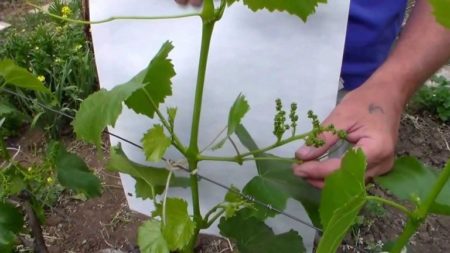
Grapes can be planted along the eaves of the roof. Then it is better to lead the plant into one stem, and pinch the second, spare one. If the greenhouse is not too high, then the grapes can be planted along the wall, forming in the form of a multi-shoulder cordon. The essence of greenhouse grape pruning is such that it will remove all excess shoots growing during the season, which quickly thicken the bush in a limited space and cast a shadow on the fruits.
In cases where other crops grow near the grape bush, they give it a standard form. Standard grapes can be grown even in a pot. The plant gives a few clusters, but they are of high quality and very good taste.
Formation begins immediately after planting a seedling. Initially, the trunk is severely cut off, and in subsequent years, all overgrown shoots are cut in half, cutting off all unripened green areas. To prevent lateral shoots from growing too quickly, pinch them in the summer, and remove them during autumn pruning. The height of the barrel can be up to one meter. Higher begins the growth of lateral branches. The crown is formed in such a way that up to two buds remain on each shoot during autumn pruning. All side stepsons are completely removed. Gradually, the main short, strong branches will form on the bush. In summer, stems will grow from these branches, which will be cut as soon as they reach a 40-centimeter length.
To obtain larger berries and large clusters, it is necessary to free the shoots from excess fruit ovaries, otherwise there will be many brushes, but they will grow small and loose. To prevent overload will allow the removal of small fruits, weak twigs, dried and yellowed leaves.
Pollination assistance
Self-pollinated grape varieties are optimal for the greenhouse, that is, in which the flowers have organs of both sexes. This approach is due to the fact that pollinating bees rarely fall within the limits of the greenhouse, and therefore pollination may not occur, therefore, there will be no harvest. If you cultivate a bee-pollinated variety, then pollination will have to be done independently. When the flowers are fully opened, you need to tap on branches or flowers so that pollen from male flowers showered on female ones. For efficiency, a fan is installed in the greenhouse, which will spread the pollen by the wind.
Top dressing
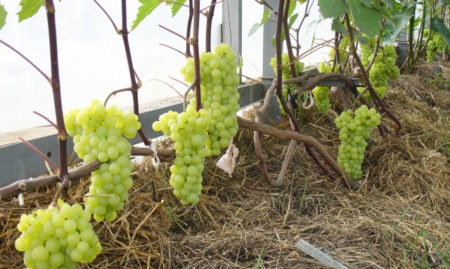
In the first year after planting, grapes do not need additional nutrition. But this is on condition that the land was generously fertilized when planting beds. Otherwise, the culture needs fourfold fertilizer:
- In the spring. Organics in the form of ammonium nitrate or urea, potassium salt, superphosphate are added to the grooves dug near the bush, 25 cm deep.The share of nitrogen fertilizers at this stage should be 45%, the share of potash fertilizers - 25%, the proportion of phosphorus - 30%.
- Two weeks before flowering. This time the earth is supplied with organic matter (diluted mullein, compost, chicken droppings), 20 grams of potassium sulfate and 25 grams of superphosphate diluted in water.
- The appearance of berries. Spend foliar top dressing with microelements.
- Ripening berries. The proportion of phosphorus and potash fertilizers is doubled. Nitrogen is completely ruled out. At this stage, wood ash can replace potassium.
Shelter for the winter
After harvesting in late September, the final watering is carried out. Moisture will nourish the roots in the winter. The vines are removed from the trellis and laid dug trenches - this will provide the wood with heat and will not allow frostbite. From above shoots are covered with spruce branches, straw, dry grass, sawdust. You can spray the bushes with insecticides and fungicides in advance to prevent the onset of the disease.
It is better if the walls and roof of the greenhouse are removed. In this case, the frame must be disassembled so that the snow creates a reliable protective layer for the grape lashes.
Fruiting problems
Often, the gardener is faced with the problem of fruiting - grapes give a very meager harvest, and the fruits are small and not sweet. Most often, the problem lies in improper agricultural technology.
Why does not fruit grapes in the greenhouse:
- there are not enough trace elements - with untimely feeding, the earth quickly depletes and ceases to fully nourish the plant. If grapes do not have enough zinc, manganese, boron and other chemical elements, its development will slow down, flowering and fruiting will be weak;
- excess nitrogen - it is important to remember that the introduction of nitrogen-containing fertilizing is advisable only at the first stage of the growing season. During the flowering and ripening of the berries, an excessive dose of nitrogen can provoke the growth of shoots and leaves, but not the fruits;
- pruning flaws - rare or incorrect pruning leads to thickening of the crown, peeling, overloading the shoots with fruits.
Rules for growing greenhouse grapes in the suburbs
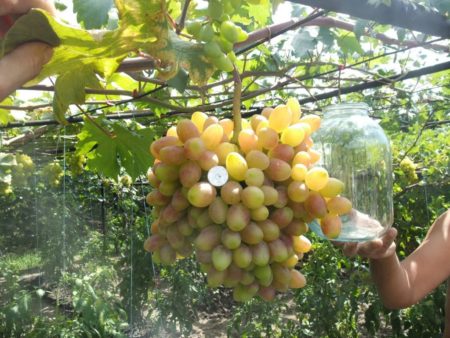
The weather in the central region of the country is changeable. Frequent temperature changes, precipitation, cooling, multi-day heat - all this affects the growth of grapes and its productivity. Therefore, in the suburbs, culture is also grown in greenhouses.
Basic principles of cultivation:
- it is recommended to choose early mid-sized grapes of the Kishmish type (seedless);
- it is better to use the wall version of the greenhouse, that is, one wall is replaced by a house wall, which adds heat to the greenhouse. The exposed parts of the greenhouse should face the south and southwest;
- for irrigation, it is preferable to use a drip irrigation system;
- since more often the soil is too acidic, chalky powder is added to the soil (loam), sand and peat when making up the soil mixture for the greenhouse;
- seedlings are planted in the greenhouse in February. Until mid-March, the greenhouse should be heated.
Rules for growing greenhouse grapes in Siberia
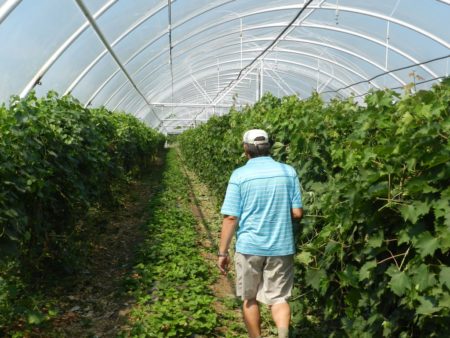
The climate of the northern part of the country is more severe than the Moscow Region. Summer is cooler and shorter there, frost starts already in early September, and spring comes late. Therefore, growing grapes there is somewhat more difficult.
Basic principles of cultivation:
- the greenhouse must be heated;
- for the Siberian climate, the most suitable varieties are: Arcadia, Laura, Aleshenka, Transparent;
- the top soil layer should be loose and light, since rooting of roots takes place in it. It is made up of turf land, sand and gravel;
- after planting, the plants are mulched so that the roots are always warm. The mulched layer can be made of compost, straw. The number of irrigations is significantly reduced;
- with the appearance of the first flower buds, nitrate root dressing is performed.It can be arranged 2-3 times with an interval of two weeks;
- after flowering, the earth is dusted with wood ash, which acts as a prophylactic against fungal infections.
Rules for growing greenhouse grapes in the Urals
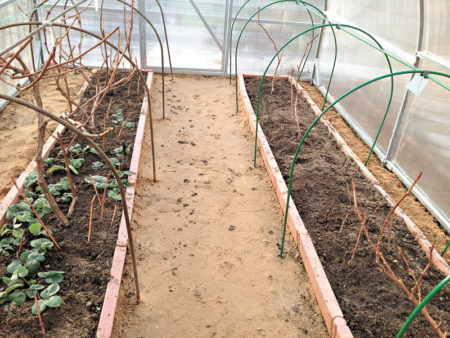
The climate of the Urals is close to the north. Cold winters and short warm and humid summers are also observed here. Since mid-summer, fungal infections have been rampant in the region. This is due to excessive soil moisture due to frequent rainfall.
Basic principles of cultivation:
- mainly green seedless varieties are suitable for the greenhouse, such as Korinka Russkaya, Rusbol (kishmish), Hybrid-342, Pamyat Dombkovskaya, Irinka;
- the soil at depth is often clayey. Therefore, before planting seedlings they dig deep holes and fill the bottom with a mixture of rotted manure, mineral fertilizers and soddy fertile land;
- grape bushes are regularly treated with contact fungicides to protect against mildew and oidium. Although this disease is extremely rare in sheltered soil, it is better to take additional measures to protect plants from an insidious disease that often appears “out of nowhere”;
- for the winter, grapes are removed from the trellis and covered with spruce spruce branches. You can fill the base of the bushes with earth or sand. A neatly twisted flexible vines cover agrospan;
- in the autumn, after harvesting, grape bushes are additionally fed with potash fertilizers. This is necessary to increase the immunity of plants and their best wintering.
Reviews
Marina
I live in the Western Urals. I prefer to grow varieties Aleshechki, Pamyat Dombkovskaya, Isabella in my area. These varieties are considered unpretentious, productive. True, the variety Pamyat Dombkovskaya clusters are small, but there are always a lot of them. The taste of berries is excellent. Isabella is a wonderful wine variety. I plant seedlings in a hole in two pieces. I leave the distance between the holes small, about 60 centimeters, since the greenhouse is small. The greenhouse goes south, so the grapes are always illuminated by the sun's rays, the ripening of the vines always happens on time. Planting is always insulated for the winter, although I do not clean the greenhouse.
Oleg
I have been growing grapes in sheltered ground for several years. I like this method of cultivation in that the culture is thus almost never affected by diseases. Everyone else knows that grapes cannot tolerate excessive humidity. Well, this does not threaten him in the greenhouse, so there will be no rot or mold. Yield also suits me - any variety in a greenhouse always shows excellent productivity, even with poor care. And the taste of the berries is no worse than that of grapes in the open ground. In general, greenhouse grape growing has some advantages.
Conclusion
Growing grapes in greenhouses takes a lot of time and effort, but the result is worth it. Thanks to this method of cultivating this culture, residents of any region of the country, even the most severe in climate, can enjoy delicious and juicy grapes. And for experienced farmers, grapes grown in greenhouses can also bring good profits.

 Non-covering winter-hardy grape varieties for Moscow region
Non-covering winter-hardy grape varieties for Moscow region How to keep the vine in winter
How to keep the vine in winter When can I transfer grapes to another place in the fall
When can I transfer grapes to another place in the fall How to cover and prepare grapes for the winter in the suburbs
How to cover and prepare grapes for the winter in the suburbs